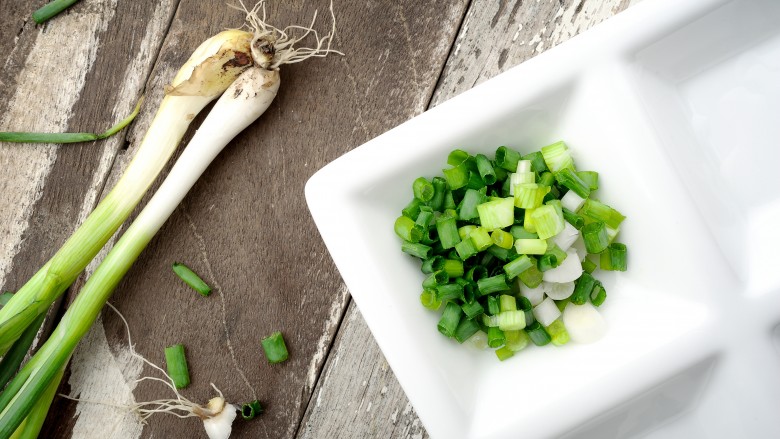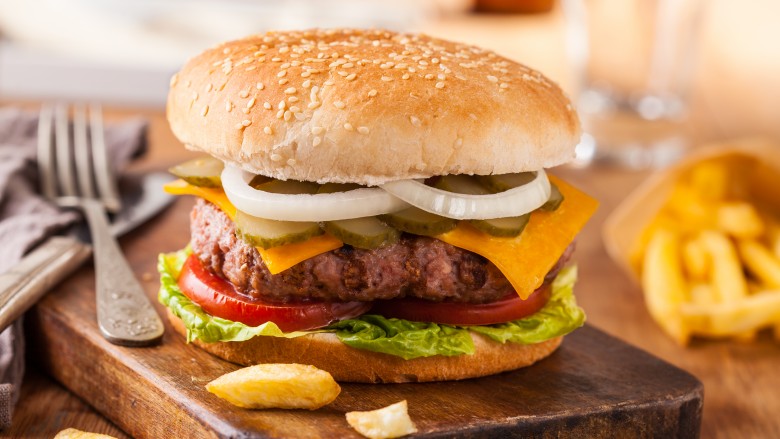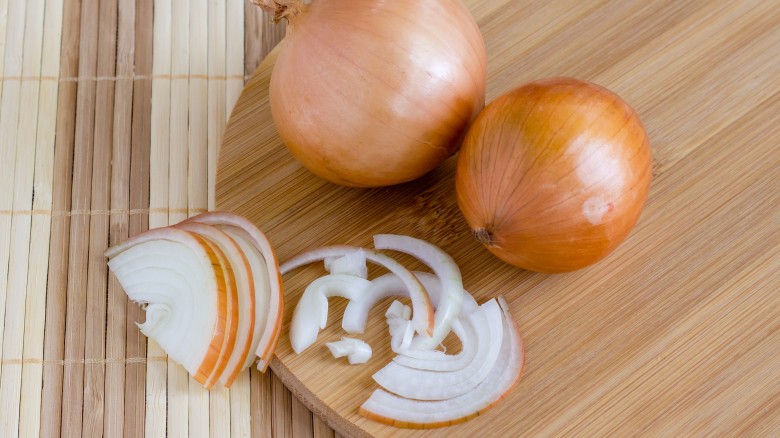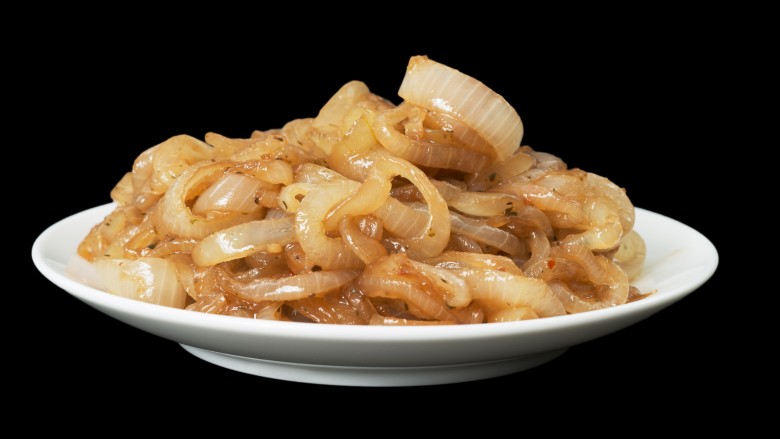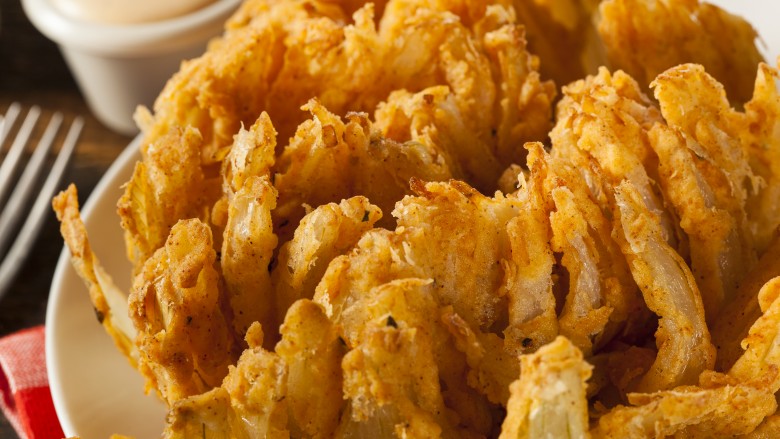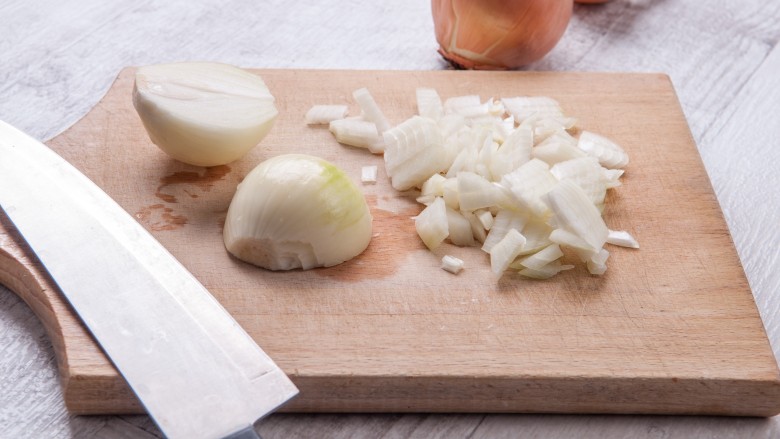You\'ve Been Cutting Onions All Wrong
Onions are a key ingredient in many dishes, so whether you like them or not, you'll probably need to cut them sooner or later. Cut, chop, slice, and dice ... there are a number of different ways to cut an onion, and your method is usually dictated by what you're making. Mastering the right techniques is crucial, and you'll taste it in the final product. So what's the right way to cut your onions?
The slice and dice
Chances are good this is the method of chopping onions you're most familiar with. There's good reason for that, as this is the shape you want for a lot of dishes. If your first action is to cut off both ends of the onion, Gordon Ramsay wants you to stop that. Ramsay says that it's important to leave the root on. It helps keep your onion together and makes it easier to cut. Your cuts will be more even in the end, which will help everything cook evenly. Ramsay also says cutting off the root releases more gases, and making the entire thing a tear-filled experience.
According to Ramsay, the right way is to cut it in half, then use three fingers to hold down the onion and guide the knife through the cuts. Cut through the onion, tip of the knife toward the root, as close to the root as possible. Rotate the onion, make two horizontal cuts parallel with the cutting board, then dice from the end. Once you get close to the root, cut off the last few bits of onion. No waste and clean, even cuts.
Preventing tears
Part of the reason you probably dread chopping onions is the inevitable burning sensation and the tears that go along with it. That's because of the enzymes you're cutting and releasing, and if you're not cutting onions with a few simple tips in mind, you're doing it wrong.
One option for cutting onions is to skip your kitchen counter and move your cutting board to the stovetop. Turn your vents on to suck up a lot of the gas before it can hit your eyes. In addition to following Ramsay's suggestion about not cutting the root of the onion (where the gas-releasing enzymes sit in their greatest concentration), you can also pop your onions in the refrigerator or freezer for a bit before you're ready to cut them. Scientific studies say most of the gas is released at room temperature. Heat stops the release of the gas — that's why you don't cry when cooking onions — and cold has the same effect. Even with those precautions, you might still cry a little, but every little bit helps!
Scallions: the basics
Scallions — or green onions, as they're sometimes called — are incredibly versatile whether you're using them for flavor or garnish. There are a couple of different ways to cut them but first, the basics.
The first thing you should be doing is cutting off the roots. Then cut off any of the green tops that look a little wilted. No one wants wilted onions in their dish, after all! But before you start slicing off those flavorful little circles, take the tip of your knife and run it along the length of the onion. Don't press too hard, you just want to remove the outer layer. That's going to make sure you're getting rid of any dirt or sand that might be left behind, and this outer layer is going to be the part that wilts first, while the inside of the onion is still perfectly fine. Removing it is going to ensure that you just have the freshest part of the onion to work with, no matter how you cut them.
There's another common mistake that's super easy to make when you're cutting scallions, no matter how you're doing it or what dish they're destined for. These onions are delicate, so chopping with a standard up-and-down motion can crush them rather than cut them. Make sure you have a sharpened blade, and when you make the cuts, slide the knife in a motion that's more horizontal than vertical. To be extra careful, try the back slice. You'll basically be cutting as you drag the knife back toward you rather than as you're pushing it away. Keep the tip of your knife on the cutting board, and cut only a single layer of scallions at a time instead of a stack.
Getting fancy with scallions
You're probably most familiar with cutting scallions in the way that gives you little rounds when you're done, but it's easy to add a little dimension to your cuts. Instead of cutting straight across the end of the onion, cut at an extreme diagonal. Use the same horizontal motion, and move the knife only the slightest bit to turn your scallions into super-thin slices. These thin slices make great garnish, and even if you have to crush them a bit to get those cuts just right, putting them in an ice bath in the fridge for at least half an hour will allow them to absorb the water you crushed out of them. They'll curl right back up.
It's also easy to make decorative garnishes with them in another way, too. Take the bottom three inches or so, trim the roots off, and make a series of cuts along about half the length of the onion. Rotate the onion and continue to cut along that same line, and you'll end up with a little onion brush.
Cutting onions for burgers
While the standard slice and dice method works great for a lot of dishes, there are some instances when you want to do something a little different to get the maximum flavor out of your onions. Everyone loves onion on burgers: the combination of beef and onion is just something special. Order a burger with raw onion at a restaurant, and you'll probably get a single, flat slice layered in there somewhere. But how often have you bitten into such a burger and had the whole thing fall apart? It's great for presentation, sure, but there's a better way to cut your onions that is great for presentation and practicality.
This one has a bit of science behind it, too, and it's basically a matter of slicing the onion so it releases the least amount of onion smell. You're eating it raw, after all, and no one wants to bite into their burger and be overwhelmed by the pungent smell of onion. Since that smell comes from the rupturing of the onion's cells, you want to cut them so you're slicing up fewer cells. That's going to give your onion more taste and less smell, which is exactly what you want for your burger.
Picture the onion like a globe, with the root at the south pole and the stem at the north pole. Start by cutting the onion in half, pole to pole. Then, make your slices so you're cutting along the line between the poles, and that's going to minimize the damage you're doing to those gas-releasing onion cells. You're going to release some of the onion flavor, but not enough to overpower your burger. And that is going to be the next step in elevating your burger game.
Turning your onion into identical slices
Sometimes, you're going to want to use onion in a dish that calls for large pieces that are going to be cooked. While the slice and dice method is good for dishes that are going to incorporate the onion in them — like sauces — sometimes you want that onion to stay in its onion form. You're going to want it to cook evenly, too, and that means cutting your onion into uniformly sized pieces.
For that, you're going to want to go back to the idea of the onion as a globe. After cutting the onion in half (from pole to pole) and placing the dome on your cutting board, cut from north to south pole in a series of slices. Instead of cutting straight down (which would be fine for, say, those onions you're going to be using on your burgers), angle the knife to keep your onion slices even. As you cut, change the angle of your knife until you get to the zenith of the dome. Then, flip your onion around and do the same thing from the other side. That's going to give you even slices that will all cook at the same rate, rather than the uneven sizes you'll get if you cut across the onion's equator.
For caramelized onions
Caramelized onions are great for a seemingly infinite number of recipes, and making them requires a bit of patience. There's a lot of technique to making them, too: start out by cutting them the right way.
One of the things you want to be sure of when you're cutting raw onions is that you're making them thick enough. You might be tempted to cut them as thin as you can, hoping to speed up a process that usually takes 30-45 minutes. That's not going to work, though, and if you're cutting your onions too thin they're going to dry out and burn rather than caramelize.
If you want your caramelized onions to come out perfect, make your slices ⅛ inch thick, straight and even. That's going to ensure they all cook evenly, and when you're cutting them you should be halving them before turning them into half-moon slices. Take your time, and you can create the perfect caramelized onion.
For onion rings
Who doesn't love onion rings? Whether you're putting them on the side or stacking them on your burger, make sure you're making the best onion rings possible, right from the start.
Cutting onions into rings can be a bit tricky, since the whole onion's round shape will give it a tendency to roll. A mandoline can be helpful, but not everyone has a mandoline. While you can use a fork to steady your onion, there's a pretty strange tool that can make the whole process much easier: a hair pick. Stainless steel works the best, and it can be used no matter what kind of cuts you're making with your onion. It's most helpful when you're making onion rings, though, and it won't leave holes as large as the fork would.
Stand your onion on end and push the hair pick through the center from pole to pole. This gives you a handy way to steady the onion and a guide for making evenly spaced cuts and rings that will cook evenly. Keep the hair pick in your arsenal of kitchen utensils and it can help you out with many types of cuts for many types of vegetables. You're welcome!
Making bloomin' onions easy
Bloomin' onions are a great appetizer that everyone loves, and they're great if you're working on a time crunch, too. There's also a super-easy way to cut them to speed up your party prep.
Cut off the stem, then flip your onion over. It should stand up easily now, root side up. If you picture the onion like a clock, start with four cuts: 12 o'clock, 3 o'clock, 6 o'clock, and 9 o'clock. Make sure you leave a decent amount of space between your cut and the root, as the root will hold the whole thing together. Once you have those angles marked, start dividing each of those sections equally. In the end, you should end up with 16 cuts, all evenly spaced, with the onion still held neatly together and anchored by the root.
Only flip it over and open it once you've finished your cuts, and you'll have your bloomin' onion!
Some general tips and tricks
No one likes cutting onions, but no one can argue that dishes are the same without them. Here are a few general tips that will help you make sure that you aren't making prep work more difficult than it needs to be.
Make sure your knife is sharpened. Since you'll be relying on the blade to slice through rather than crush your onions, it makes all the difference in the world when you keep those blades sharp. And in this case, use a chef's knife. The weight of the blade will make cutting easier than with a smaller knife, and the length of the blade makes it easier, too.
Make sure your cutting board is going to stay put. This is doubly important given the shape of the onion, and if you're trying to cut it into rings, an unsteady cutting board is going to put your fingers at risk. Use a nonslip mat or try putting a damp towel (or paper towel) underneath the board. That'll keep it from slipping, no matter what you're doing.
Once you've chopped your onion, there's one last mistake many people make. When it's time to put them in the pan, you already have the knife in your hand, so the logical thing to do is to run the blade along the cutting board and use your hand to help scoop up the onions. Unfortunately, that's one of the best ways to ruin that knife you've tried so hard to keep sharp. Either flip the knife over and use the the spine of the blade or pick up any one of a number of kitchen scoops and shovels made just for that purpose. Your knife — and future onions — will thank you!


